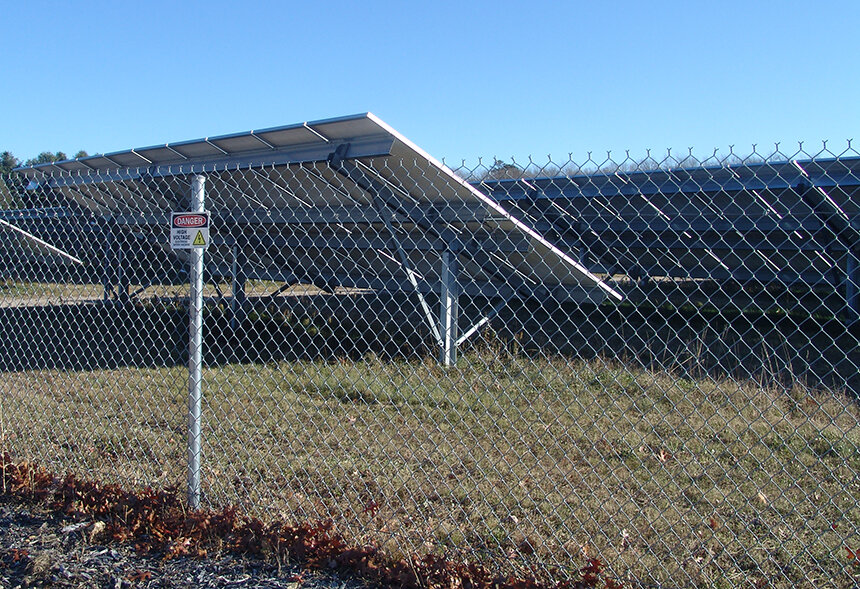House Bill Would Help Define Rhode Island Solar-Siting Policy
April 18, 2022

Where do you put something almost everyone wants, but no one wants to see next door?
Solar projects have mushroomed in Rhode Island. New projects in 2020 added 152 megawatts to the electric grid, raising the state’s solar energy capacity to 555 megawatts — enough to power 108,211 homes. And 8.81 percent of the state’s total electricity now comes from solar energy, good news as the state struggles to meet emission-reduction goals in the Act on Climate law.
The solar industry has expanded almost as quickly as it has angered residents. For municipalities, the developments are a win-win-win, providing jobs — the solar sector employs 1,010 people statewide — reducing carbon emissions and helping limit overdevelopment. But the same industry has cleared 1,041 acres of open space for ground-mounted solar arrays.
Residents complain solar developments are located on the wrong sites, on clear-cut forestland, green space or too close to residential areas. Neighbors complain ground-mounted solar facilities are eyesores, negatively impact property values and are noisier than people think. Warwick became the latest municipality to restrict solar projects to development areas and preferred sites, away from homes and undeveloped land.
The constant tug of war between residents and solar developers has made its way to the Statehouse. Rep. June Speakman, D-Warren, introduced legislation (H7531) earlier this session that would prohibit net-metering projects in Rhode Island Department of Environmental Management (DEM) conservation opportunity areas.
“Conservation opportunity areas,” according to the bill, include “core forests (unfragmented forest blocks greater than 250 acres, high value and high vulnerability habitat, natural heritage areas which represent known occurrences of rare species), important coastal habitats, and corridors (largely undeveloped paths that connect the core natural areas, river corridors, and other pathways).”
“It’s another attempt to bring order to statewide solar-siting policy,” Speakman told legislators during a recent hearing before the House Corporations Committee. The bill also proposes incentives for siting solar projects on landfills, gravel pits, golf courses, brownfields and other already-developed sites.
Representatives from the solar industry came out against the bill, specifically taking aim at the language around conservation opportunity areas. Nick Nybo, an attorney for Warwick-based Revity Energy, told legislators the definition was a non-starter, and claimed it would prohibit locating solar projects on developed properties like Providence Place mall.
“We have 28 solar facilities across the state … that fall within DEM’s definition of conservation opportunity area,” Nybo said. “That is 70 million kilowatt-hours of solar energy that, if this law existed five years ago, the state of Rhode Island would not have today.”
Joe Walsh, business manager for the International Brotherhood of Electrical Workers Local 99, told legislators the solar development community wants more tools to locate parcels for projects.
“There is no alternative right now,” Walsh said. “I think we haven’t seen that map that’s going to show all the different places where we say, ‘OK, there is a spot there for development. Is that land available for sale? Is there a moratorium? Is there infrastructure?’”
Grow Smart Rhode Island’s Scott Millar, who owns property that contains core forestland, told legislators the bill’s impact on property owners like himself would be minimal.
“I would not be allowed to cut forests to put in utility-scale solar,” Millar said. “However, I can still put solar on my roof, I can still put a ground-mounted solar of 40,000 square feet in an old field that I have on my property.”
Warwick resident Jane Austin testified that state incentives benefited solar development at the expense of conservation areas.
“Solar development does not have to be done in forested sites,” she said. “One of its characteristics is that it can be extremely compatible with many other activities.”
But alternative placements for solar projects took a hit earlier this year when National Grid announced it planned to end financial incentives for solar canopies on parking lots and carports. The utility company cited increasing costs of materials due to the pandemic’s supply chain shortages and questioned the benefit for developers.
A 2020 report by Synapse Energy Economics Inc. showed that already-developed properties could host between 3,390 and 7,340 megawatts of renewable power. Much of that potential is on developed commercial and industrial sites and parking lots, according to the report.
Speakman told committee members that a new version of H7531 was already in the works. “I’ve got a lot of direction from a variety of stakeholders,” she said.
The new version of the bill is expected to remove the definition of conservation opportunity areas for a greater emphasis on protecting core forest sites.
Categories
Join the Discussion
View CommentsRelated Stories
Your support keeps our reporters on the environmental beat.
Reader support is at the core of our nonprofit news model. Together, we can keep the environment in the headlines.
We use cookies to improve your experience and deliver personalized content. View Cookie Settings



